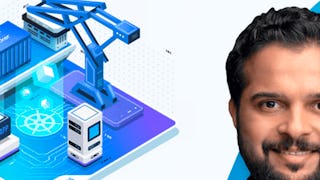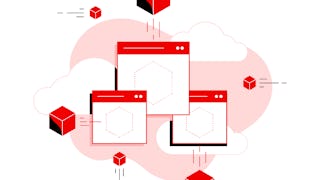Machen Sie den nächsten Schritt in Ihrer Karriere als Softwareentwickler, indem Sie sich in Container-Tools und -Technologien ausbilden lassen! Das Durchschnittsgehalt für Jobs, die Container-Kenntnisse erfordern, liegt laut salary.com in den USA bei 137.000 US-Dollar, sodass Devops-Profis und Entwickler mit diesen Kenntnissen sehr gefragt sind. Mehr als 70 Prozent der Fortune-100-Unternehmen führen containerisierte Anwendungen aus. Aber warum?



Einführung in Containers mit Docker, Kubernetes & OpenShift
Dieser Kurs ist Teil mehrerer Programme.
Unterrichtet in Deutsch (KI-Synchronisation)


Dozenten: Alex Parker
133.737 bereits angemeldet
Bei  enthalten
enthalten
(981 Bewertungen)
Empfohlene Erfahrung
Was Sie lernen werden
Lernen Sie, wie Sie mit Hilfe von Containern Anwendungen schnell in jeder Umgebung verschieben können.
Erstellen Sie native Cloud-Anwendungen mit Docker, Kubernetes, OpenShift und Istio.
Beschreiben Sie die Kubernetes-Architektur und nutzen Sie sie, um ein auf dem gesamten Lebenszyklus basierendes Container-Management-System einzurichten und zu verwenden.
Erstellen und nutzen Sie eine YAML-Bereitstellungsdatei, um Ressourcen wie Pods, Services, Replicasets und andere auf deklarative Weise zu konfigurieren und zu erstellen.
Kompetenzen, die Sie erwerben
- Kategorie: Kubernetes
- Kategorie: Cloud-natives Computing
- Kategorie: Docker (Software)
- Kategorie: Befehlszeilen-Schnittstelle
- Kategorie: Containerisierung
- Kategorie: Skalierbarkeit
- Kategorie: Microservices
- Kategorie: YAML
- Kategorie: Istio
- Kategorie: CI/CD
- Kategorie: Bereitstellung von Anwendungen
- Kategorie: OpenShift
Wichtige Details

Zu Ihrem LinkedIn-Profil hinzufügen
8 Aufgaben
Erfahren Sie, wie Mitarbeiter führender Unternehmen gefragte Kompetenzen erwerben.

Erweitern Sie Ihre Fachkenntnisse
- Lernen Sie neue Konzepte von Branchenexperten
- Gewinnen Sie ein Grundverständnis bestimmter Themen oder Tools
- Erwerben Sie berufsrelevante Kompetenzen durch praktische Projekte
- Erwerben Sie ein Berufszertifikat von IBM zur Vorlage

In diesem Kurs gibt es 5 Module
Beginnen Sie Ihre erste Woche damit, sich mit den Konzepten, Funktionen, Anwendungsfällen und Vorteilen von Containern vertraut zu machen. Aufbauend auf Ihrem neuen Wissen über Container lernen Sie, was Docker macht und warum Docker bei Entwicklern so beliebt ist. Sie erfahren, was Docker ist, machen sich mit den Docker-Prozessen vertraut und erkunden die Docker zugrunde liegende Technologie. Erfahren Sie, wie Entwickler und Unternehmen von der Verwendung von Docker profitieren können und welche Situationen für die Verwendung von Docker eine Herausforderung darstellen. Als Nächstes lernen Sie, wie Sie mit einer Dockerdatei ein Container-Image erstellen, wie Sie mit diesem Image einen laufenden Container erstellen, machen sich mit der Docker-Befehlszeilenschnittstelle (CLI) vertraut und lernen häufig verwendete Docker-Befehle kennen. Sie werden sich mit Docker-Objekten, Dockerfile-Befehlen und der Benennung von Container-Images vertraut machen und lernen, wie Docker Netzwerke, Speicher und Plugins verwendet. Anschließend können Sie dieses Wissen in die Praxis umsetzen, wenn Sie die Komponenten der Docker-Architektur in Aktion sehen und die Containerisierung mit Docker erkunden. Am Ende dieser ersten Woche werden Sie ein Image aus einer Docker Hub Registry ziehen. Sie werden ein Image als Container mit Docker ausführen, ein Image mit einer Dockerdatei erstellen und taggen und dieses Image in eine Registry einspeisen.
Das ist alles enthalten
6 Videos2 Lektüren2 Aufgaben2 App-Elemente4 Plug-ins
In Woche zwei lernen Sie, was Container-Orchestrierung ist. Anschließend erfahren Sie, wie Entwickler mit Hilfe der Container-Orchestrierung komplexe Lebenszyklen für die Entwicklung von Container-Umgebungen erstellen und verwalten können. Kubernetes ist derzeit die beliebteste Plattform für die Container-Orchestrierung. Sie werden die wichtigsten Komponenten der Kubernetes-Architektur untersuchen, einschließlich der Komponenten der Steuerungsebene und der Controller. Sie lernen Kubernetes-Objekte kennen und erfahren, wie bestimmte Kubernetes-Objekte wie Pods, ReplicaSets und Deployments funktionieren. Dann lernen Sie, wie Entwickler die Kubernetes-Befehlszeilenschnittstelle (CLI) oder "kubectl" verwenden, um Objekte zu manipulieren, Arbeitslasten in einem Kubernetes-Cluster zu verwalten und grundlegende kubectl-Befehle anzuwenden. Sie werden in der Lage sein, die Vor- und Nachteile der Verwendung von imperativen und deklarativen Befehlen zu unterscheiden. Am Ende dieses Moduls werden Sie die kubectl CLI-Befehle verwenden, um Ressourcen in einem echten Kubernetes-Cluster zu erstellen. Am Ende dieser Woche werden Sie die Kubernetes CLI verwenden, um einen Kubernetes-Pod zu erstellen, ein Kubernetes-Deployment zu erstellen, ein ReplicaSet zu erstellen und den Kubernetes-Lastenausgleich in Aktion zu erleben.
Das ist alles enthalten
6 Videos1 Lektüre2 Aufgaben2 App-Elemente4 Plug-ins
In Woche drei lernen Sie ReplicaSets, Autoscaling, Rolling Updates, ConfigMaps, Secrets und Service Bindings kennen und erfahren, wie Sie diese Funktionen zur Verwaltung von Kubernetes-Anwendungen nutzen können. Sie erfahren, wie ReplicaSets Anwendungen skalieren, um der steigenden Nachfrage gerecht zu werden, und wie Autoscaling eine dynamische, bedarfsorientierte Skalierung ermöglicht. Sie erfahren, wie Sie rollende Updates verwenden, um Anwendungsaktualisierungen zu veröffentlichen und Änderungen zurückzunehmen, ohne die Benutzererfahrung zu unterbrechen. Sie werden lernen, wie Sie ConfigMaps und Secrets verwenden, um Konfigurationsvariablen und sensible Informationen für Ihre Bereitstellungen bereitzustellen und Ihren Code sauber zu halten. Am Ende der Woche werden Sie Anwendungen, die in Kubernetes bereitgestellt werden, skalieren und aktualisieren.
Das ist alles enthalten
5 Videos2 Lektüren2 Aufgaben2 App-Elemente3 Plug-ins
In Woche vier erfahren Sie mehr über das wachsende Kubernetes-Ökosystem und lernen weitere Tools kennen, die gut mit Kubernetes zusammenarbeiten und die Cloud-native Entwicklung unterstützen. Sie lernen die Gemeinsamkeiten und Unterschiede zwischen Red Hat ® OpenShift® und Kubernetes kennen und sehen, wie die OpenShift-Architektur aussieht. Sie lernen OpenShift-Builds und BuildConfigs sowie OpenShift-Build-Strategien und -Trigger kennen. Außerdem erfahren Sie, wie Betreiber ganze Anwendungen mühelos bereitstellen können. Schließlich werden Sie untersuchen, wie das Istio Service Mesh den Datenverkehr und die Kommunikation zwischen den Diensten einer Anwendung verwaltet und sichert. Am Ende der Woche werden Sie die oc CLI verwenden, um Befehle auf einem OpenShift-Cluster auszuführen. Und Sie werden die OpenShift-Build-Funktionen nutzen, um eine Anwendung aus dem in einem Git-Repository gespeicherten Quellcode bereitzustellen.
Das ist alles enthalten
4 Videos1 Lektüre2 Aufgaben1 App-Element3 Plug-ins
Im Rahmen des Abschlussprojekts werden Sie die in diesem Kurs erlernten Tools und Konzepte in die Praxis umsetzen und eine einfache Gästebuchanwendung mit Docker und Kubernetes bereitstellen. Die gesamte Anwendung wird auf OpenShift implementiert und verwaltet.
Das ist alles enthalten
3 Lektüren1 peer review3 App-Elemente3 Plug-ins
Erwerben Sie ein Karrierezertifikat.
Fügen Sie dieses Zeugnis Ihrem LinkedIn-Profil, Lebenslauf oder CV hinzu. Teilen Sie sie in Social Media und in Ihrer Leistungsbeurteilung.
Dozenten


von
Mehr von Cloud Computing entdecken
 Status: Kostenloser Testzeitraum
Status: Kostenloser Testzeitraum
KodeKloud
 Status: Kostenloser Testzeitraum
Status: Kostenloser Testzeitraum Status: Preview
Status: Preview Status: Preview
Status: Preview
Warum entscheiden sich Menschen für Coursera für ihre Karriere?




Bewertungen von Lernenden
981 Bewertungen
- 5 stars
66,36 %
- 4 stars
19,36 %
- 3 stars
4,99 %
- 2 stars
4,89 %
- 1 star
4,38 %
Zeigt 3 von 981 an
Geprüft am 19. Okt. 2021
I audited this course, but it was pretty much what I hoped for. Nice hands on exercises that are the core of a good training course for me.
Geprüft am 22. Juni 2021
Very good introduction to the basic concepts of Containerization and Kubernetes. Good examples to get a starting feel on how to work with such tools
Geprüft am 12. Dez. 2022
Necessary concepts are explained nicely and in a detailed manner.The virtual environment for the course is working properly and nice to gain experience on

Neue Karrieremöglichkeiten mit Coursera Plus
Unbegrenzter Zugang zu 10,000+ Weltklasse-Kursen, praktischen Projekten und berufsqualifizierenden Zertifikatsprogrammen - alles in Ihrem Abonnement enthalten
Bringen Sie Ihre Karriere mit einem Online-Abschluss voran.
Erwerben Sie einen Abschluss von erstklassigen Universitäten – 100 % online
Schließen Sie sich mehr als 3.400 Unternehmen in aller Welt an, die sich für Coursera for Business entschieden haben.
Schulen Sie Ihre Mitarbeiter*innen, um sich in der digitalen Wirtschaft zu behaupten.
Häufig gestellte Fragen
für diesen Kurs gibt es keine festen Voraussetzungen, aber wir empfehlen, dass Sie "Einführung in das Cloud Computing" abgeschlossen haben und über die folgenden Kenntnisse verfügen: - Grundlegende Computerkenntnisse und ein Verständnis der wichtigsten Cloud-Konzepte - Verständnis der Kommandozeile und der Shell-Befehle
Wir empfehlen Ihnen, den Kurs "Einführung in das Cloud Computing" vor der Teilnahme an diesem Kurs zu absolvieren.
Der Zugang zu Vorlesungen und Aufgaben hängt von der Art Ihrer Einschreibung ab. Wenn Sie einen Kurs im Prüfungsmodus belegen, können Sie die meisten Kursmaterialien kostenlos einsehen. Um auf benotete Aufgaben zuzugreifen und ein Zertifikat zu erwerben, müssen Sie die Zertifikatserfahrung während oder nach Ihrer Prüfung erwerben. Wenn Sie die Prüfungsoption nicht sehen:
Der Kurs bietet möglicherweise keine Prüfungsoption. Sie können stattdessen eine kostenlose Testversion ausprobieren oder finanzielle Unterstützung beantragen.
Der Kurs bietet möglicherweise stattdessen die Option 'Vollständiger Kurs, kein Zertifikat'. Mit dieser Option können Sie alle Kursmaterialien einsehen, die erforderlichen Bewertungen abgeben und eine Abschlussnote erhalten. Dies bedeutet auch, dass Sie kein Zertifikat erwerben können.
Weitere Fragen
Finanzielle Unterstützung verfügbar,



